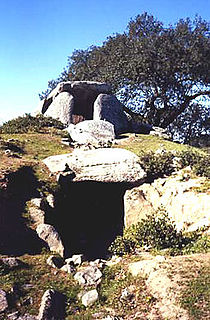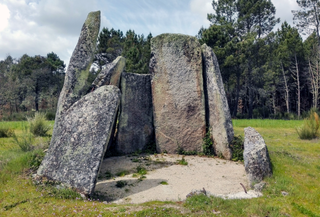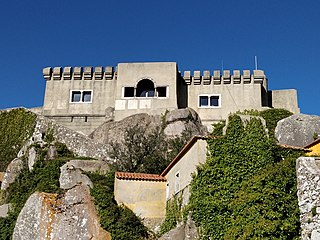
Sintra is a town and municipality in the Greater Lisbon region of Portugal, located on the Portuguese Riviera. The population of the municipality in 2011 was 377,835, in an area of 319.23 square kilometres (123.26 sq mi). Sintra is one of the most urbanized and densely populated municipalities of Portugal and hosts several cities albeit the seat of the municipality is the town of Sintra proper. A major tourist destination famed for its picturesqueness, the municipality has several historic palaces, castles, scenic beaches, parks and gardens.

Petroforms, also known as boulder outlines or boulder mosaics, are human-made shapes and patterns made by lining up large rocks on the open ground, often on quite level areas. Petroforms in North America were originally made by various Native American and First Nation tribes, who used various terms to describe them. Petroforms can also include a rock cairn or inukshuk, an upright monolith slab, a medicine wheel, a fire pit, a desert kite, sculpted boulders, or simply rocks lined up or stacked for various reasons. Old World petroforms include the Carnac stones and many other megalithic monuments.
Great Dolmen of Zambujeiro is a megalithic monument located in Nossa Senhora da Tourega, near Valverde, in the municipality of Évora, considered one of the biggest such structures in the Iberian Peninsula.
This article describes several characteristic architectural elements typical of European megalithic structures.

The Prehistoric Rock-Art Site of Escoural Cave is a structure known for its Paleolithic-era rock-art and funerary burial site, located in the Portuguese municipality of Montemor-o-Novo, in the civil parish of Santiago do Escoural.

The Dolmen of Cunha Baixa is a dolmen in the civil parish of Cunha Baixa, in the municipality of Mangualde. It is located in a valley area of the Rio Castelo, between the villages of Cunha Baixa and Espinho.

The Great Dolmen of Comenda da Igreja is a megalithic funerary site in the civil parish of Nossa Senhora do Bispo, in the municipality of Montemor-o-Novo, in the central Alentejo region of continental Portugal.

Dolmen of Carapito I is a megalithic monument located in the civil parish of Carapito, in the municipality of Aguiar da Beira in the Guarda District of Portugal.

Trefignath is a Neolithic burial chamber near Trearddur, south of Holyhead on Holy Island, off Anglesey in Wales. In its most complete form it included a large cairn covering three stone tombs, set on a small knoll. It was excavated between 1977 and 1979, revealing several phases of occupation with three separate burial chambers built in succession. It is a scheduled ancient monument, maintained by Cadw.

The Sanctuary of Peninha is situated in the Sintra Mountains in the Sintra-Cascais Natural Park, in the Lisbon District of Portugal. It stands at an altitude of 448 metres on top of a rocky outcrop, which provides views over the coastline and inland areas. In addition to a baroque chapel, completed in 1710, the location contains the Palace of Peninha, which dates from 1918, as well as remains of a hermitage. The interiors of neither the chapel nor the palace can presently be visited.

Anta is the Portuguese name for about 5,000 megaliths built during the Neolithic period in the area of Portugal. The Anta das Pedras Grandes is a late-Neolithic site located in Casal Nova in the parish of Caneças, in the Odivelas municipality, in the Lisbon District of Portugal. It was classified as a National Monument in 1944. Excavations in the early 21st century suggest that it was originally built as a dolmen or single-chamber megalithic tomb, consisting of a polygonal long chamber with eight supporting stones about 3 metres tall, and a short access corridor. There are traces of a tumulus, and human bones have been discovered. Excavations in the surrounding area also identified many flint chippings, suggesting that the area was used for the production of flint items.

The Anta do Monte Abraão was a megalithic dolmen located in the parish of Monte Abraão, in Queluz, Sintra Municipality, Lisbon District, Portugal. The dolmen was first identified in 1876, by Carlos Ribeiro, who carried out excavations until 1878 and published his results in 1880. Excavations suggest that it served as a tomb for about 80 individuals and that it dates back to the middle to end of the Neolithic period. The Anta do Monte Abraão and the nearby Anta da Pedra dos Mouros and Anta da Estria are collectively known as the Antas de Belas.

The Anta da Pedra dos Mouros, also known as the Anta do Senhor da Serra, is a megalithic dolmen situated near Belas and Queluz in the Lisbon District of Portugal. It is believed to date back to the late-Neolithic and early-Chalcolithic eras. The Anta da Pedra dos Mouros, the Anta da Estria, and the Anta do Monte Abraão are a short distance from each other and are collectively known as the Antas de Belas. The Anta da Pedra dos Mouros was first identified in the 1850s by Carlos Ribeiro. Despite being registered and protected as a national monument in 1910, the dolmen has recently suffered significant damage.

The Anta de Agualva, also known as the Anta do Carrascal, is a megalithic dolmen situated in an urban area of Agualva-Cacém in the municipality of Sintra, in the Lisbon District of Portugal. First identified by Carlos Ribeiro in 1875, the dolmen has recently been restored and can be easily visited.

The Anta de Carcavelos, located close to the village of Carcavelos near the town of Lousa in the municipality of Loures in the Lisbon District of Portugal, is a stone age dolmen or megalithic monument from the Chalcolithic period. It is one of many such tombs that have been identified in Portugal.

The four Artificial caves of Casal do Pardo, also known as the Caves of Quinta do Anjo, were neolithic tombs. They are situated in Palmela municipality in the Setúbal District, of Portugal, about 25 km (16 mi) south of the capital of Lisbon. These caves were classified as a National Monument of Portugal in 1934.

The Vale Maria do Meio Cromlech is a megalithic stone circle situated in Évora district in the Alentejo region of Portugal. It is believed to date back to the fifth millennium BCE or earlier, and is classified as a National Monument.

The Antas do Olival da Pêga are located near the village of Telheiro, in the municipality of Reguengos de Monsaraz, in the Évora district of the Alentejo region of Portugal. Anta is the Portuguese name for a dolmen, a single-chamber megalithic tomb. These two neolithic dolmens were used over a long period, from the late neolithic to the chalcolithic. The tombs were originally identified by the German archaeologists, Georg and Vera Leisner, who excavated Anta 1, with Anta 2 being subsequently excavated from the 1990s by Victor Gonçalves and Ana Catarina Sousa of the Centre of Archaeology of the University of Lisbon (UNIARQ). In addition to the visible stones at the two sites, which are about 300 meters apart, many items have been found as a result of excavations. Over one hundred people were buried in each tomb. The proximity of the two tombs gives rise to the conclusion that both were part of the same megalithic complex.

The Anta da Vidigueira is a megalithic dolmen or burial chamber located southwest of the village of Freixo, in Redondo municipality in the Évora district of the Alentejo region of Portugal. The dolmen was probably constructed between the Neolithic and the Chalcolithic. It has been classified as a National Monument since 1910.

The Antas do Barrocal, also known as the Antas Herdade do Barrocal, are a set Neolithic dolmens, or megalithic funeral chambers, at Monte do Barrocal, in the parish of Nossa Senhora da Tourega, in the Évora District of the Alentejo region of Portugal. They are in an area with a high concentration of megalithic sites. Nine have been identified but only two are more than remnants and only Number 1 can be visited. This has been classified as a National Monument since 1910.




















